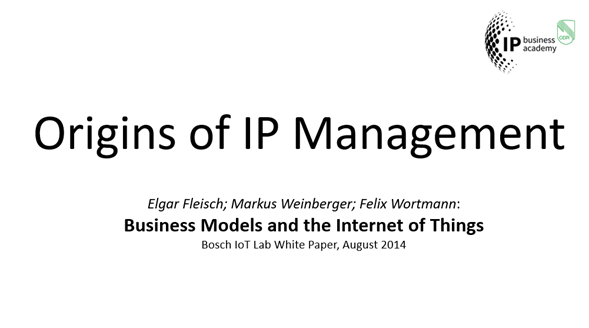Origins of IP Management – Episode 1 „Business Models and the Internet of Things“
In this “Origins of IP Management” episode we want to discuss the Paper: Fleisch/Weinberger/Wortmann: „Business Models and the Internet of Things“, Bosch, Technical Report, 9/2014
Cannot open the video? Please click: https://youtu.be/QHYpyUsDVf0
This paper was a very important contribution to various discussions that have become extremely important for IP strategy development today. It linked the development of (Industrial) IoT, which was still in its infancy at the time, to business model considerations.
 That’s why we use the concepts in this publication in two of our Distance Learning courses at CEIPI in IP Management, the “IP Strategy Development” course and the course on “IP and Industry 4.0“.
That’s why we use the concepts in this publication in two of our Distance Learning courses at CEIPI in IP Management, the “IP Strategy Development” course and the course on “IP and Industry 4.0“.
The article provides theoretically and practically grounded assistance to companies how to develop and implement business models that use the Internet of Things.
The most important question is: How do companies create value by using the Internet of things. The answer which is given in this paper is a layer logic which can be applied to understand the value creation.
This layer model is extremely important for understanding IP strategies in the digital transformation.
 If you want to analyze the patent portfolios of two companies, such as Sonos and Spotify, the layered model helps to understand how these two companies have built their portfolios and how the patent portfolios help to secure the two different business models. This is because in both cases identical use cases are depicted – for example, listening to music in the SmartHome environment without using their own physical data carriers.
If you want to analyze the patent portfolios of two companies, such as Sonos and Spotify, the layered model helps to understand how these two companies have built their portfolios and how the patent portfolios help to secure the two different business models. This is because in both cases identical use cases are depicted – for example, listening to music in the SmartHome environment without using their own physical data carriers.
The layer model distinguishes five different layers, which are counted through from bottom to top. This means you start with the physical layer, i.e. the layer of physical objects such as a loudspeaker.
The second layer contains sensors and actuators. This means that the physical object is enabled to perceive itself and its environment and to interact with it, and it has a certain intelligence of its own through microprocessors.
The third layer contains the connectivity, i.e. the speaker can connect to the Internet via WiFi.
 In the fourth layer in the cloud, computing power is made available, data is added, networking is achieved in the global network, and analytics are performed.
In the fourth layer in the cloud, computing power is made available, data is added, networking is achieved in the global network, and analytics are performed.
The result is a digital service in the fifth layer, for example, a multi-room music service such as that offered by Sonos.
The crucial point is that the patent portfolios of Spotify and Sonos are structured completely differently and the patent strategies are also fundamentally different, as the business models are fundamentally different.
Sonos has traditionally developed its business model in a transaction-oriented manner. The company sells speakers and the customer purchases the speakers, which can connect to WiFi and then connect to music services and play music over the Internet and the associated app. That means Sonos thinks its business model on the picture from the bottom up, so from the physical layer up into the cloud-based service – that’s the classic IoT view.
 Spotify has developed its business model completely differently and you can see that in its patent portfolio. Spotify comes from a cloud-based music streaming service and does not offer physical assets, nor is it interested in physical assets. From Spotify’s perspective, the physical world is purely an infrastructure that only serves to make Spotify’s various use cases possible and tangible. The relationship-oriented business model and the associated patent portfolio is thought of from the top down on the layered diagram – exactly opposite to the IoT line of thinking.
Spotify has developed its business model completely differently and you can see that in its patent portfolio. Spotify comes from a cloud-based music streaming service and does not offer physical assets, nor is it interested in physical assets. From Spotify’s perspective, the physical world is purely an infrastructure that only serves to make Spotify’s various use cases possible and tangible. The relationship-oriented business model and the associated patent portfolio is thought of from the top down on the layered diagram – exactly opposite to the IoT line of thinking.
The fundamental work of Elgar Fleisch, Markus Weinberger and Felix Wortmann from 2014 helps to systematically analyze and develop IP strategies for the protection of digital business models today. This makes this publication an important foundation for IP management.



